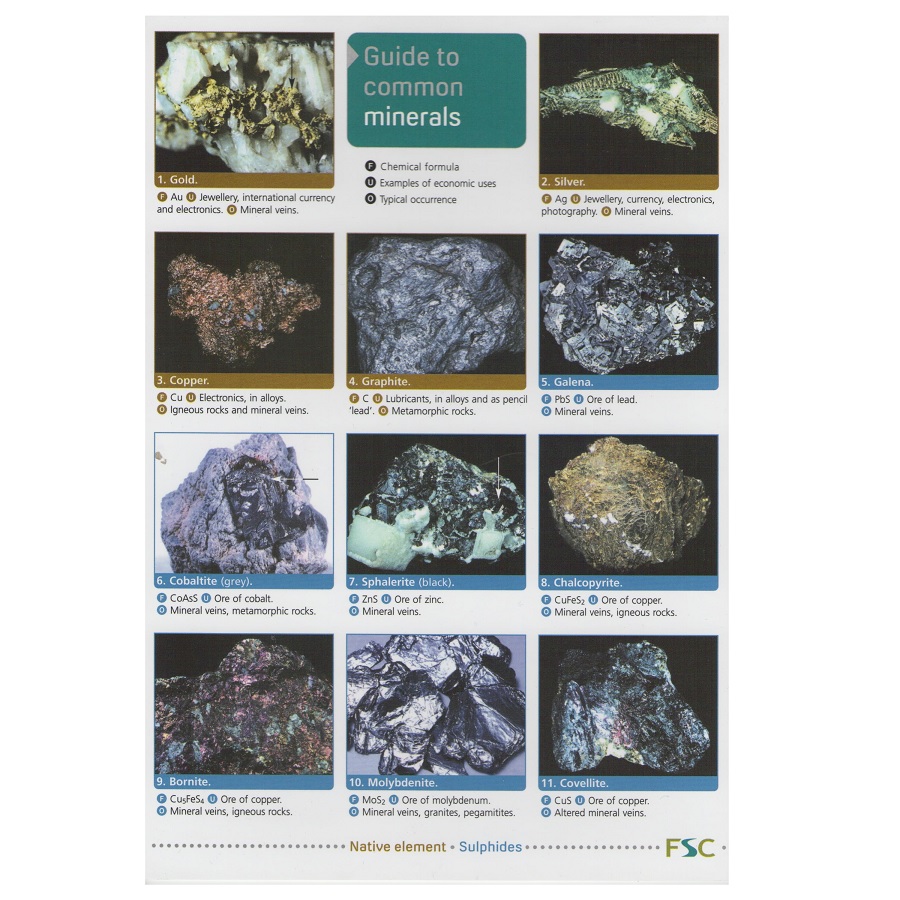- “Bringing The Past, Into the Future”
- +44 (0) 1204 388754

PRODUCTS BY WEIGHT
BOX SETS
PLASTIC DISPLAY PRODUCTS
PRODUCTS BY WEIGHT
BOX SETS
PLASTIC DISPLAY PRODUCTS
The ‘Guide to Common Minerals’ is designed for use in the field, classroom and laboratory, this 12-page chart features clear colour photographs of 71 common minerals. A comprehensive table gives an overview of the colour, hardness, lustre, mineral habit, cleavage and fracture properties of the minerals pictured. Information on the field occurrence, formation and economic uses of minerals is also included. Clear colour illustrations and text by experts in the subject make these valuable resources for all age groups.
Out of stock
Agglomerate igneous rock specimens from Scotland, UK. A coarse grained, hard blocky rock exhibiting a conglomeration of various minerals and igneous material of volcanic origin. These samples formed part of the Glen Coe caldera and are apart of the upper streaky andesite unit, the exhibit poor sorting and orientation of material which indicates a somewhat violent origin but this can vary from agglomerates by location and is mainly down to the chemistry of the igneous material. The samples are available in 3 sizes and come supplied in a card tray with a label, they are suitable for educational use to show the different types of volcanic rocks produced as well as those interested in collecting rock samples.
Specimens of Basalt, collected from Northern Ireland. Basalt is a common, extrusive igneous rock, that forms when magma erupts and cools quickly on the Earth’s surface. These specimens are part of the Antrim lava group and date to the Tertiary period, around 60 million years ago. This is the same as the Basalt that makes up the famous Giant’s Causeway. The chemistry of these specimens suggests that the rock is olivine basalt, and comprises plagioclase feldspar, olivine and augite. These specimens are available in multiple sizes and come in a white card tray with an information label.
We also supply Basalt thin sections for microscope study which are available to buy HERE.
10 in stock
Specimens of Chrome Diopside that were collected from the Gusdal Olivine Pit, Åheim, Norway. These samples are best described as chrome bearing diopside. Diopside, a vivid green pyroxene mineral, features streaks of grey chromite that creates a stunning mineral sample that would be the perfect addition to any collection. Whilst many samples of chrome diopside tend to be crystalline in nature, our samples are unique as the feature a grainier, more crumbly texture. These specimens are in limited availability, so we recommend you move fast if you wish to add these stunning specimens to your collection. They are available in a range of sizes and come supplied in a white card tray with information label.
Dunite igneous rock specimens from the Gusdal olivine pit in Åheim, southern Norway. Composed of green olivine minerals with chromite and pyroxene crystals, the rock forms as intrusive igneous plutons in the earth mantle down to 400 km deep and displays a coarse texture and green colouration. Overall, the samples are fairly granular and weak due to their chemistry and form part of the basal gneiss complex of southern Norway. Ideal for various levels of collectors and for higher level education and research use, the samples are available in three sizes and come supplied in a card tray with an information label.
We also supply Dunite thin sections for microscope study which are available to buy HERE.
Specimens of Epidote from Michigan, USA. In particular, they have been collected from the Laurium Mine, Osceola, Houghton County. Epidote is an abundant rock forming mineral that is most commonly green in colour. These specimens date from the Stenian period, approximetely 1 – 1.2 billion years ago. These specimens are available in limited supply, with two different size options. They come supplied in a white card tray with information label.
Beautiful Quartz tea Light Holders, each made from 100% natural quartz crystals and equipped with a cushioned base. Each item showcases unique variations in colour, texture, and formations, making them one-of-a-kind. The soothing tones of quartz, create a captivating visual display that resonates with the serenity of nature. Each tea light holder spans a spectrum of colours from clear to cloudy white, and we have equipped them all with a cushioned base. This protects your furniture from scratches or damage. Since these items are made from 100% natural quartz, please note that some scratches and staining may be visible. Enhance your home with our Quartz Tea Light Holders, bringing a touch of the earth’s beauty into your everyday life.
Trachyte, a common igneous rock composed of various minerals including quartz, feldpsars, micas and olivine, rock specimens come from East Lothian, Scotland and are available in optional sizes, supplied in a card tray with a label.
Introducing an outstanding triplet hand lens with a remarkable x 10 magnification and a wide 21 mm viewing field. This loupe enables detailed examination of specific areas within a sample. Crafted using three precision-ground glass elements (triplet optics), it delivers exceptionally clear vision. Additionally, this model features both LED and UV lighting options, making it an ideal tool for geologists and entomologists. In particular, for ex the fluorescent properties of minerals, crystals, and insects.
The lighting system consists of a ring of six bright white LEDs that enhance the visibility of your chosen sample. The single UV LED emits longwave fluorescence, causing many materials to emit a glowing effect in the dark.
Encased in durable plastic housing that seamlessly integrates with a stainless steel body, this loupe is powered by three LR297 button batteries (included). It comes with a key for easy battery replacement, and a leather case for added convenience. This versatile lens is an indispensable tool across various professions including geology, sedimentology, mineralogy, entomology, botany, jewelry making, gem cutting, and more